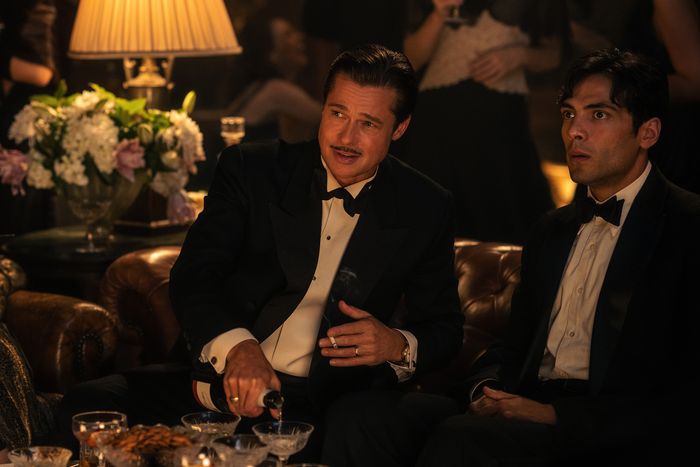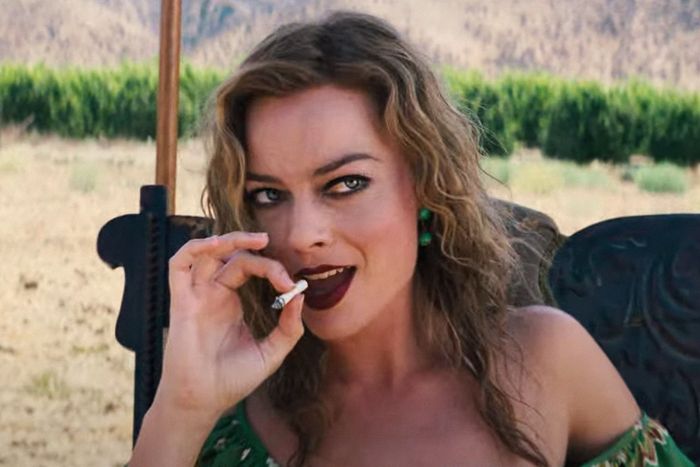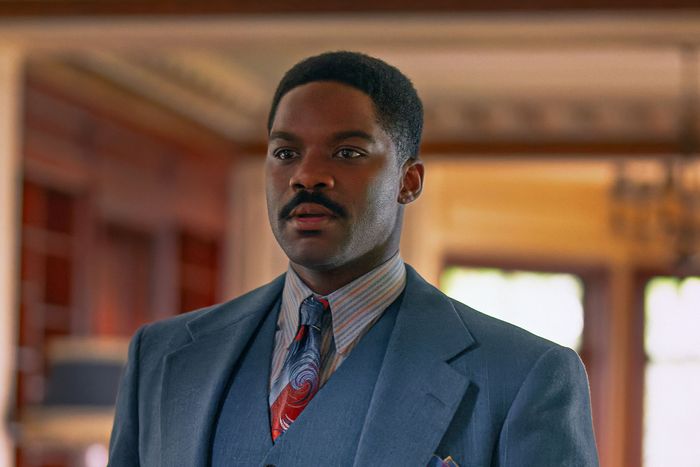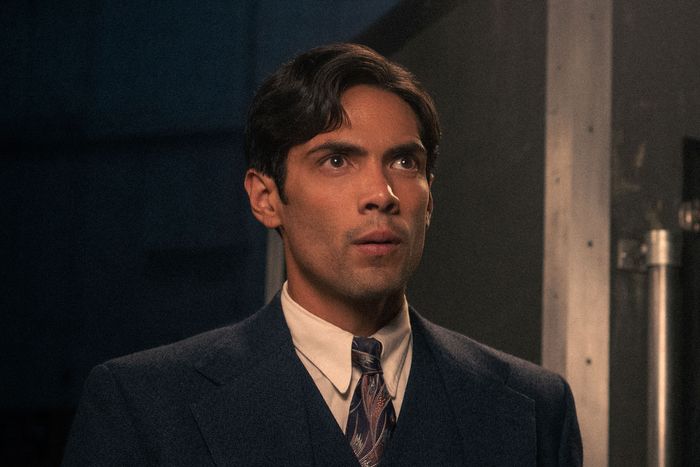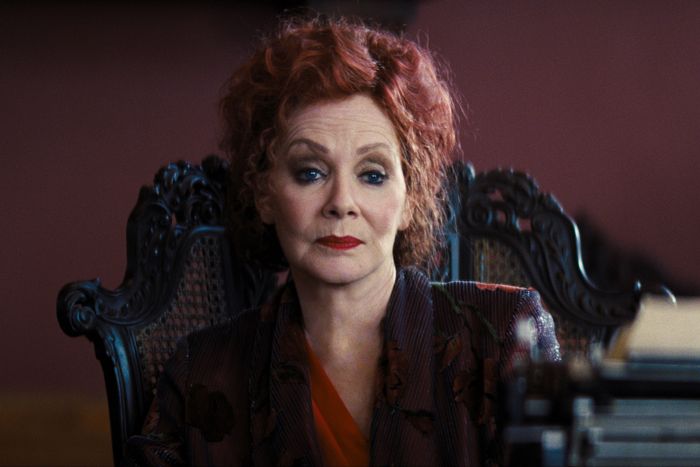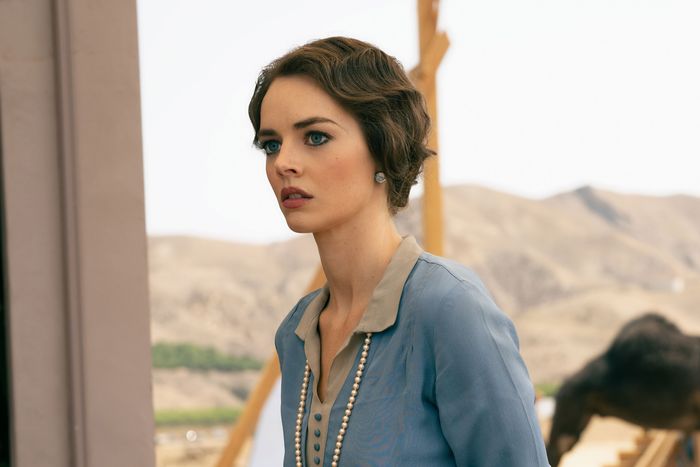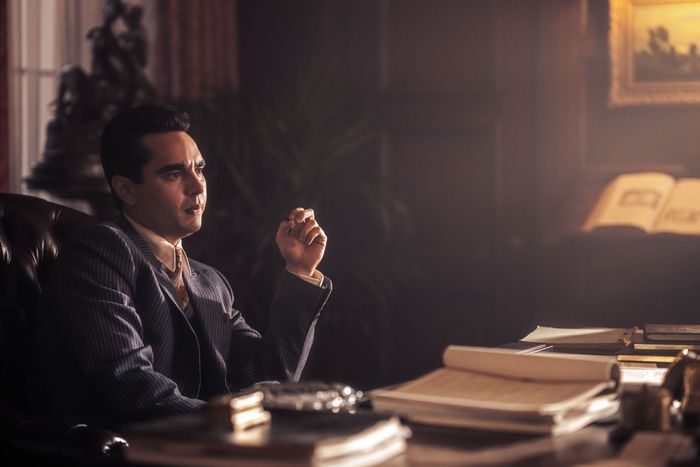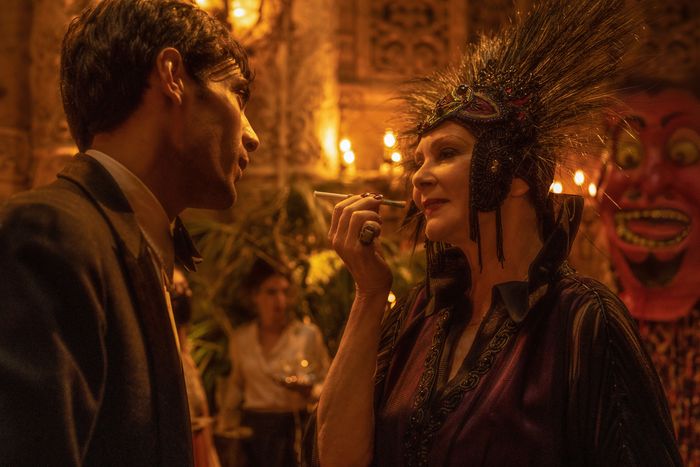
The image of Hollywood as a new Babylon, a place populated by perverts, hop heads, and loose women whose depravity is communicable through the movie screen, goes all the way back to the silent era. The movies’ first major scandal broke over Labor Day 1921, when a sometime actress named Virginia Rappe died after a raucous, boozy party at the St. Francis hotel in San Francisco. Comedian Roscoe “Fatty” Arbuckle was charged with her rape and murder, and the tabloid headlines kept blaring throughout Arbuckle’s three trials. He was acquitted on the third. But his career was ruined, and Hollywood’s sinful reputation was set.
Damien Chazelle’s latest film, Babylon, opens in 1926, when silent Hollywood was a fast-moving train unaware that it was about to hurtle off of a cliff with the release of The Jazz Singer one year later. The introduction of sound changed everything, from the way films were shot to who starred in them. Babylon wallows in the excitement — and misery — that came in the wake of that shift. One of Chazelle’s key sources is Hollywood Babylon, filmmaker Kenneth Anger’s gossipy (and mostly untrue) compendium of Hollywood’s bad behavior from the early days of the medium up through the late ‘50s.
Chazelle’s other primary source is more reputable: The Parade’s Gone By…, a nearly 600-page tome by British filmmaker Kevin Brownlow that documented the then-untold story of early Hollywood. That book came out in 1968, at which point many of the players on the silent scene were still alive to share their experiences firsthand. Brownlow records their memories verbatim, as actors, directors, and assistants describe anarchic days not unlike the jazzy “day in the life” sequence midway through Chazelle’s film.
Babylon bends reality to suit its purposes. Not only does it incorporate legends taken directly from Hollywood Babylon — a book that, again, has been proven to be mostly bullshit — it also takes liberties in crafting its ensemble. While some of the characters are based on a single historical figure, others are blends of multiple real-life personalities or simply representations of a type. Together, they offer a glimpse into an art form, and a social scene, that lived fast and died young.
The Core Cast
The Leading Man
Damien Chazelle has left no mysteries on how to interpret melancholy leading man Jack Conrad: In an interview with EW in November, he said that the character of Jack Conrad is a blend of John Gilbert, Clark Gable, and Douglas Fairbanks. Of the three, Gilbert is the most prominent influence; the top note, if you will. After Rudolph Valentino, Gilbert was the premiere romantic leading man of the 1920s, a hearty, virile all-American figure who was beloved by men and women alike (for different reasons, of course). In The Parade’s Gone By… cameraman Clarence Brown recalls shooting a “horizontal love scene” — one of cinema’s first — with Gilbert and Greta Garbo for Flesh and the Devil (1926). That film sparked a love affair between its stars that kept fans entertained and gossip columnists busy for a solid year.
John Gilbert drank heavily and loved prolifically. He was married four times, and was romantically connected to many more women, some of whom were married to other people. His friend, director King Vidor, wrote in his autobiography A Tree Is a Tree that Gilbert was emotionally immature and uneasy with his fame, and “when he began to read the publicity emanating from his studio calling him ‘the great lover,’ his behavior in real life began to change accordingly. It was a difficult assignment to live up to.”
On that note, the story of how John Gilbert fell from grace is consistent across sources, though the amount of venom in the telling differs (Kenneth Anger is the meanest, naturally). Moviegoers did laugh at Gilbert’s line delivery in his first talkie, His Glorious Night (1929), as they do in Babylon. Anger speculates that someone at MGM deliberately sabotaged Gilbert by raising the pitch of his voice to make it sound “squeaky,” an allegation repeated by actress Louise Brooks in The Parade’s Gone By… For his part, Brownlow says that early sound technology made everyone’s voice sound higher than it was, while film historian Richard Koszarski lays the blame on bad screenwriting in his book An Evening’s Entertainment. Regardless, Gilbert’s demons ultimately won, and he died of a heart attack complicated by alcoholism at the age of 39.
Also in the mix are Douglas Fairbanks, a powerful and worldly star who spent much of the 1920s doing swashbuckling period pictures, and Clark Gable, who inherited Gilbert’s suave mustachioed leading-man mantle once the older man’s career started to sputter in the early sound era.
The It Girl
Babylon’s primary female protagonist, wild child actress Nellie LaRoy, is also a cocktail of classic Hollywood stars. Her primary inspiration is Clara Bow, the “It Girl” who goes unmentioned in The Parade’s Gone By… — an egregious snub, considering Bow’s immense popularity in the late ‘20s and early ‘30s. But she gets quite an airing in Hollywood Babylon. Kenneth Anger devotes an entire chapter to rumors about Bow’s love life, including her purported fondness for “partying” with the entire USC football team during boozy all-night poker games. And while her sexual voracity is almost undoubtedly exaggerated, Clara Bow was known for living the wild flapper life she embodied on screen, and was hated by the Hollywood upper crust as a result. (Her working-class background didn’t help.)
The story about the football players makes it into Chazelle’s Babylon, as does an apocryphal tale about the collision between Bow’s voice and early sound equipment. As Anger writes: “The sound-mixing engineer in the monitor room, unfamiliar with the Brooklynese boom of Clara’s voice, didn’t tune down his dials for Clara’s greeting. She made her entrance, hollered ‘HELLO EVERYBODY’ — and blew every valve in the recording room.” But while it’s true that Clara Bow talked with a Brooklyn accent, the connection between her voice and her decline isn’t as direct as Hollywood Babylon or Singin’ in the Rain — another movie with a character based on Clara Bow — makes it seem.
Her star image as the living representation of carefree youth couldn’t last forever, particularly not during the Great Depression. And Bow’s preference for silent film’s more spontaneous style of directing (see Ruth Adler’s entry below for more on that) affected her ability to act in sound pictures as much as her accent did. Clara’s hard-partying lifestyle had begun to damage her mental and physical health as well, and a scandalous tell-all from her former private secretary Daisy DeVoe — and the subsequent defamation lawsuit — nudged Clara off the public stage and into seclusion by 1933. One detail that Babylon does get right is Nellie’s trip to visit her mother in a mental asylum in New York: Clara Bow’s mother had schizophrenia, and Bow had her committed after she tried to kill her daughter one night in 1922, shortly before Clara decamped for Hollywood.
Other influences on the character of Nellie LaRoy include Joan Crawford, who also made her debut in the silent era as a free-spirited, sexually uninhibited “jazz baby” type, but whose longevity would far outlast Clara Bow’s. Chazelle also name-checks two actresses best known for their tragic falls: Jeanne Eagels, a former chorus girl who merits a one-line mention in Hollywood Babylon for her death by overdose in 1939 (she was posthumously nominated for an Academy Award for her last film, 1929’s The Letter, which Anger fails to mention), and Alma Rubens, Hollywood’s poster girl for the dangers of drug addiction. Rubens appeared in the infamous “cocaine comedy” The Mystery of the Leaping Fish opposite Douglas Fairbanks in 1916; the film featured an addict detective named “Coke Ennyday.” And indeed, cocaine use was ubiquitous among silent comedians. But it was Alma’s subsequent addiction to heroin, not cocaine, that killed her — she died in 1931 after a very public breakdown and multiple stints in sanitariums.
The Thwarted Pioneer
Lady Fay Zhu (Li Jun Li), a Sapphic siren with a sideline in writing interstitial titles for films (a real occupation that went out with the silents), loosely blends two real-life figures. First is Anna May Wong, the pioneering actress who was Hollywood’s first Chinese-American star. Wong was born in 1905 near Los Angeles’ Chinatown, where her parents owned a laundry business like Zhu’s in Babylon. Wong started as an extra in the late 1910s, and became a star in the ’20s after appearing opposite Douglas Fairbanks in The Thief of Baghdad in 1924. Moralists opposed Wong’s “vamp” image, and she struggled to get cast by producers who were timid about violating regional laws against “miscegenation” (i.e., interracial relationships). With few Asian leading men to choose from, there were few roles for Anna May Wong, whose fashionable flapper persona should have made her a natural romantic lead. Frustrated with losing Asian parts to white actresses in yellowface, she moved to Europe in 1928. She came back two years later, but her relationship with Hollywood was never the same.
Marlene Dietrich, meanwhile, started her career in Europe, where she became a star on the strength of her performance as cabaret singer Lola Lola in Josef von Sternberg’s The Blue Angel (1930). From there, the duo decamped to Hollywood, where Dietrich caused an uproar by singing a cabaret number dressed in a tuxedo and kissing a woman on the lips in Morocco (1930), for which she received her only Academy Award nomination. (The lyrics of Dietrich’s song were not quite as scandalous as Lady Fay’s ode to “pussy,” but her commanding aura was much the same.) Rumors of Dietrich’s bisexuality flew through old Hollywood, where she was part of the clandestine “sewing circle” of lesbian and bisexual female stars documented in Axel Madsen’s 1994 book of the same name. Kenneth Anger doesn’t devote as many pages to Dietrich as you might think, perhaps because there was no shame in her omnivorous appetites. But he does credit her with launching a nationwide trend of women wearing slacks in 1932.
The Jazz Artist
A jazz trumpeter who steps out from the orchestra box to become a star in his own right, Sidney Palmer (Jovan Adepo) stands in for the Black musicians who were exposed to national audiences for the first time in the early sound era. Musical short films were one way to take advantage of the new possibilities of the “talkies,” and from 1929 through the 1930s, Hollywood producers put jazz artists like Louis Armstrong and Duke Ellington on sound stages and filmed them performing musical numbers overlaid with loose plot lines. The 1929 film Black and Tan Fantasy combines melodrama and jazz performance, starring Ellington as a bandleader whose star (and girlfriend) dies of a weak heart after performing too vigorously on stage.
But though these shorts brought Black music to wider (i.e. white) audiences, changing tastes and making money in the process, racist storylines and concessions to Jim Crow laws like Sidney experiences in Babylon were common. Louis Armstrong shorts in particular are full of demeaning racial stereotypes, and Armstrong plays servile characters derived from the racist spectacle of minstrel shows. We don’t know if Armstrong — also a trumpet player — privately objected to the roles he played in these films; his agency (or lack thereof) over his public persona is still a matter of debate for historians. We do know that, unlike his fictional counterpart, Armstrong continued to work in the motion picture industry, making Sidney’s principled flight from the studio lot after he’s humiliated on set an act of wistful historical revisionism.
The Bootstrapper
There’s no specific real-life hook to Babylon’s audience surrogate, Manny Torres (Diego Calva), a jack-of-all-trades for power broker Don Wallach (more on him later) who ends up becoming an influential producer in his own right. But Manny’s background growing up in the Chicano community on Los Angeles’ east side is consistent with several of the real-life figures on this list: Anna May Wong was an L.A. native, as was director Dorothy Arzner. Dramatic upward mobility was also common in silent Hollywood, where an industry was being built from the ground up, and lots of hands were needed to fill newly invented roles like “movie producer.” As a result, many of the stories in The Parade’s Gone By… start much like Manny’s: Someone was in the right place at the right time, someone else said, “you there! come here,” and a legendary career began.
The concept of a producer was introduced relatively late in the silent-film cycle, and their roles remain both vague and all-encompassing. They originated as “supervisors,” observers who were brought in by studios to make sure that directors stayed on schedule and within their allotted budgets. They were hated as a result: One director, Maurice Tourneur, returned to France rather than submit to the bureaucratic authority of a Hollywood producer. Eventually, the creatives relented, but not without much grousing. The Parade’s Gone By… refers to producers as “glacier watchers,” as in “they stand around making sure the studio isn’t engulfed by a glacier.” Still, for an ambitious, resourceful young person like Manny, the opportunities provided by this ill-defined, all-powerful position were endless.
The Supporting Players
The Prime Suspect
Babylon opens with an orgiastic party scene whose most depraved activities take place behind closed doors. The sequence opens with a large man, Orville Pickwick (Troy Metcalf), lying on the floor of an upstairs bedroom. An inebriated woman straddles his prone, naked body and begins to urinate on him while he squeals in delight. To each their own, but the golden shower turns into something much more serious later on when Chazelle cuts back to that same woman, foaming at the mouth and seemingly dead.
Don Wallach’s fixers manage to cover up that particular (fictional) event. But the “wild party with tragic consequences” is a clear reference to the Virginia Rappe/Roscoe Arbuckle case, one of the defining scandals of early Hollywood. Kenneth Anger, of course, plays up the sensationalism with graphic details of the alleged sexual assault and subsequent negligent homicide in Hollywood Babylon. The truth, as Karina Longworth explains it on an episode of her podcast You Must Remember This, is more nuanced.
The Blabbermouth
The consequences of inviting a gossip columnist like Elinor St. John (Jean Smart) to a Hollywood bacchanal could be devastating — but not as bad as the consequences of not inviting her. St. John is a stand-in for Louella Parsons, the most feared woman in Hollywood, a journalist who penned the first nationally syndicated movie gossip column for the Los Angeles Examiner. Parsons accomplished this by cozying up to newspaper magnate William Randolph Hearst, whom Parsons thanked for her ongoing employment by continually praising actress Marion Davies (Hearst’s mistress) in print.
Like St. John, Parsons considered herself an impartial observer of the Hollywood party scene as well as an integral part of its workings. And more than one actor made the mistake of telling Parsons something in “confidence” that ended up as a front-page headline later on. Anger mocks her chatty style in Hollywood Babylon, introducing her as “the original, panting, go-getting Paganini of Piffle, Louella ‘Oneida’ (I-Saw-What-You-Did!) Parsons.” In retrospect, it’s remarkable that Parsons went unchallenged for as long as she did: It wasn’t until 1938, more than twenty years into Parsons’ career, that her arch-rival Hedda Hopper set up a competing column at the Los Angeles Times.
The Woman Director
Female film directors like Ruth Adler (Olivia Hamilton) were more common in silent Hollywood than they would be for decades afterwards. Her masculine wardrobe recalls that of Dorothy Arzner, a pioneering woman director who had to walk a very fine line as a semi-closeted lesbian in ‘20s and ‘30s Hollywood. Like Adler, Arzner successfully made the transition from silent to sound. And — aside from social crusader Lois Weber, who specialized in films with moral instruction for the masses — Arzner was the only woman director in Hollywood from 1927 up to her retirement in 1943.
Arzner directed Clara Bow in The Wild Party (1929), a college comedy with a premise similar to that of the sound picture Ruth and Nellie are shooting in Babylon. (The Wild Party was also the first “talking picture” to come out of Babylon studio Paramount Pictures.) The “sweatbox” that makes a cameraman pass out in that scene may be somewhat exaggerated, according to accounts in The Parade’s Gone By…, but the drastic change in directing styles was real. In the silent era, director King Vidor recalls, “sometimes [actors] didn’t even read the script, but there was a thing that went on, almost telepathic, between the director and the actor. Things developed in scenes while the camera was going.” By contrast, on a soundstage the director had to do all their communicating with their actors between takes, which sucked a lot of the spontaneity from the process.
The German Expressionist
Germany’s influence on early Hollywood was profound. In the 1920s, German films were considered the pinnacle of creative sophistication, and executives eager to bolster their studio’s reputations lured directors like F.W. Murnau, Fritz Lang, Erich von Stroheim, Josef von Sternberg (Austrian, but close enough), and Ernst Lubitsch to Hollywood with promises of big budgets and creative freedom.
These men’s expressionist style of filmmaking left a mark on their American counterparts, and Murnau’s critically acclaimed 1927 romantic drama Sunrise: A Song of Two Humans proved especially influential. Otto, the maniacal German film director played by Spike Jonze, bears a special resemblance to Lubitsch, whom actress/producer Mary Pickford recalls in The Parade’s Gone By… as tempestuous, crude, and prone to shouting in broken English. (Pickford and Lubitsch famously disliked each other, so take that with a grain of salt.)
America’s Sweetheart
The buttoned-up starlet who’s introduced early on in the film, and then promptly overshadowed by the more uninhibited Nellie, is named after a real person. But the real Constance Moore didn’t start working in pictures until the late ‘30s. There was also a Colleen Moore, who pioneered the “flapper” image before Clara Bow snatched her wild-child crown. Moore and Bow appeared together in one film, Painted People (1924). During the production of that film, Clara Bow did have a suspiciously timed sinus procedure that left her unable to complete the picture, but it was Bow who ended up taking the fall for that one, not Moore.
Babylon’s Constance Moore has a level of power over her career that’s more reminiscent of a handful of silent stars: Norma Talmadge, Gloria Swanson, and especially Mary Pickford, the original “America’s Sweetheart.” Although her onscreen persona exuded innocence, the real Pickford was an astute businesswoman who produced her own films and maintained control over every aspect of the production process. She co-founded United Artists with Charlie Chaplin, D. W. Griffith, and her future husband Douglas Fairbanks in 1919, consolidating her behind-the-scenes power. But her onscreen star started to fade in the mid-‘20s — around the time that Clara Bow came onto the scene.
The Wunderkind Producer
Hollywood wunderkind and super-producer Irving Thalberg is one of a handful of historical figures who appear in Babylon under their real names: Marion Davies (Chloe Fineman) and William Randolph Hearst (Pat Skipper) also attend the stuffy bourgeois party towards the end of the movie. Thalberg has the most consistent presence of these characters, however. Throughout the film, he hovers in the background observing key turning points in cinema history alongside the taller, but equally inscrutable, Don Wallach (Jeff Garlin) — a stand-in for MGM head Louis B. Mayer.
Writing about Thalberg in a 1927 profile, journalist Allene Talmey complained that Mayer’s second-in-command had too stable of a background, and that Thalberg’s middle-class upbringing and mild-mannered personality didn’t make for good copy. Thalberg’s youth was his greatest asset: He was 21 when Universal co-founder Carl Laemmle left him in charge — at the time, he was Laemmie’s secretary— while the boss went on a trip abroad. He was 26 when Mayer poached him and made him head of production at MGM. As a result, many in Hollywood underestimated Thalberg at first. Before long, however, he gained a reputation as the shrewdest executive in the business, someone who could actually help solve creative problems and had impeccable taste in scripts and stars. He died young, too, passing away after a short bout with pneumonia at the age of 37.
The Deaths by Despair
Despair was so common in early Hollywood that the story of George Munn (Lukas Haas), Jack Conrad’s perpetually heartbroken producer who dies by suicide, isn’t specific enough to be traced to one person. In keeping with its nose for unscrupulous news, Hollywood Babylon devotes multiple chapters to Hollywood players who died in this way. Anger takes special pleasure in embellishing the sad stories of men like MGM executive Paul Bern, who died of a self-inflicted gunshot wound two months after marrying platinum blonde actress Jean Harlow in 1932. As with the fictitious Munn, alcohol was a complicating factor in many of these events: Take actor Robert Ames, whose 1931 demise is flippantly declared a suicide in Anger’s book but whose official cause of death was delirium tremens caused by alcohol withdrawal.
The Pill Pusher
The nature of their business ensures that the names of Hollywood drug dealers aren’t recorded in history like those of their clients. Still, Chazelle’s reference in casting comedian Rory Scovel as mild-mannered pill pusher The Count is as literal as it can be, given the circumstances. Hollywood Babylon describes a “quiet, gentlemanly actor on the Sennett lot known as ‘The Count’” who introduced Alma Rubens to heroin. The Parade’s Gone By… leaves out the nickname, but also references “a charming, apparently inoffensive actor” who was personally responsible for the drug-related deaths of multiple silent stars. “Somebody would have a hangover and he’d say, ‘I’ll fix it for you,’” director Eddie Sutherland recalled in 1968. “And that was that.”


